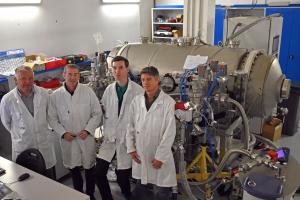Vacuum lab
Ensuring leak test sensitivity
20 May 2019
-
Kirsten Haupt
A helium leak test is one of several factory acceptance tests planned for the sectors of the ITER vacuum vessel before they are shipped to ITER. In a vacuum laboratory in the basement of ITER Headquarters, work is underway now to prepare and qualify the procedure and equipment.
Liam Worth, Gilles Wolfers, Sergei Nasluzov and Christopher Jarrige (from left to right) are using a one-cubic-metre vacuum chamber to ensure that the leak-detection tool—a mass spectrometer—is capable of the level of sensitivity needed for the vacuum vessel sector factory acceptance leak test.
The nine sectors of the ITER vacuum vessel are in fabrication now in factories in Korea (four sectors) and Europe (five sectors). Each sector is welded together from four individual segments, which in turn are built from several smaller segments. A single vacuum vessel sector stands 13 metres tall, is 6.5 metres wide and 6.3 metres deep, and weighs approximately 400 tonnes.
Sealed on either side by field joints, each sector is an independent double walled structure. A distance of 20 cm separates the sector's inner and outer walls, creating a 20-cubic-metre interspace that is filled with shield blocks and cooling water piping.
Due to the number of welds in a vacuum vessel sector, the factory acceptance leak test is a crucial step in proving the absolute leak tightness of the component before shipment. Leakage of any material into the plasma volume could contaminate the plasma and potentially cause the fusion reaction to stop.
The ITER Organization is developing and qualifying the test procedure and equipment that will be employed on the first vacuum vessel sector to be completed—sector #6 in Korea. The manufacturer—Hyundai Heavy Industries—is responsible for conducting the test, but there is close collaboration with the ITER Organization for its preparation, set-up and realization.
During the acceptance leak test, powerful pumps will remove the air from the interspace to create a vacuum, while the entire sector sits in a giant enclosure or "bag" filled with helium. A leak in the sectors shells would allow helium to seep into the interspace where it would be detected by a mass spectrometer leak detector.
In the vacuum laboratory at ITER, vacuum design and construction officer Liam Worth and his colleagues are assessing the sensitivity of the mass spectrometer and the functionality of the procedure itself. "If we don't achieve the required level of sensitivity we will not be able to establish whether or not the vacuum vessel sector is indeed leak tight," says Worth. The team is testing the diagnostic using a small vacuum chamber (1 m³) that mimics the test vacuum in the sector interspace.
One of the challenges is to ensure that the mass spectrometer can detect minute amounts of helium against the background "noise" of outgassing—the release of gas particles from the surface of materials as a consequence of the manufacturing process.
To gauge this effect, a gas with a similar composition as the one expected in the vacuum vessel interspace is injected into the test vacuum chamber. "Simultaneously, we add helium to see whether the mass spectrometer leak detector is able to identify even small quantities of helium against the 'background' of the outgassing," says vacuum design technician Sergei Nasluzov, who is responsible for the acceptance test qualification. "We need to be certain that the level of sensitivity of our detection instruments meets the requirements for the acceptance test."
According to Worth, the likelihood of a leak in the vessel sector's shells is very small, as the sectors have been manufactured to rigorous technical specifications. In the unlikely event that operators do detect a leak during the acceptance test, they would need to scan the surface of the vessel—in particular the welds—with a hand-held helium spray gun to localize the leak and repair it.
The team will finalize preparations before this summer when test equipment—two mass spectrometers, vacuum pumps, and vacuum instrumentation—will be shipped to Korea for the factory acceptance test.


